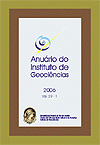Closed depressions in karstic-quartzitic relief, Ribeirão Santana basin, mid-valley of the Paraíba do Sul river
DOI:
https://doi.org/10.11137/2006_2_87-100Abstract
Karstic features generally develop in carbonatic rocks, but can also occur in siliciclastic rocks, as quartzites. The present research aims to create superficial morphology mapping and reconnaissance of karstic area deposits in quartzitic rocks. The study was developed in the hydrographic basin of the Ribeirão Santana (210 km²), mid-valley of the Preto river, a tributary of the Paraíba do Sul river, located between the states of Rio de Janeiro and Minas Gerais, Brazil. Aerial photographs at 1:25.000 scale were reconstituted in 3D environments, resulting in a planimetric and altitudinal map at 1:10.000 scale. Closed depressions, concavities with and without channels and deposits, were detached from these maps. Precise field topographic surveys at 1:500 scale resulted in planimetric and altitudinal maps related to identified forms. Also, soil samples were collected in the valley basins and depressions and analyzed according to their color, texture and grain morphoscopy criteria. Such study resulted in soil profiles for deposits confined at the bottoms of depressions and schematic representations of sediments from valley bottoms and slopes. The results indicate that the closed depressions a generally positioned at the limit of the drainage. In all sampler from the slope and fluvial valley bottom deposits the sand fraction predominates over fine particles, which were probably carried away in solution. Similar to the literature description, deep organic and/or hydromorphic profiles were found in depressions confined deposits. The present data can contribute to future geologic, hydrologic and geochemical characteristics to interpretet the origin and development of karstic featuresDownloads
Download data is not yet available.
Downloads
Published
2006-01-01
How to Cite
Uagoda, R., Avelar, A. de S. and Coelho Netto, A. L. (2006) “Closed depressions in karstic-quartzitic relief, Ribeirão Santana basin, mid-valley of the Paraíba do Sul river”, Anuário do Instituto de Geociências. Rio de Janeiro, BR, 29(2), pp. 87–100. doi: 10.11137/2006_2_87-100.
Issue
Section
Article
License
This journal is licensed under a Creative Commons — Attribution 4.0 International — CC BY 4.0, which permits use, distribution and reproduction in any medium, provided the original work is properly cited.















